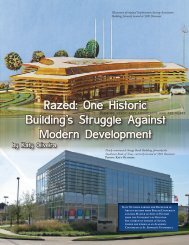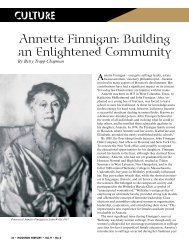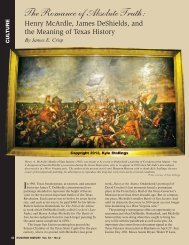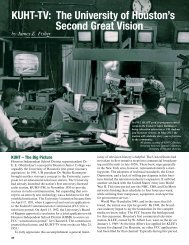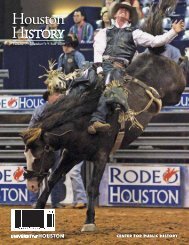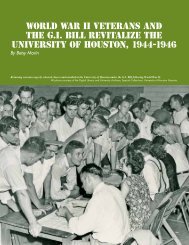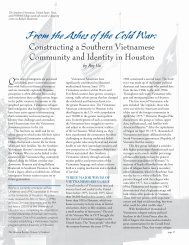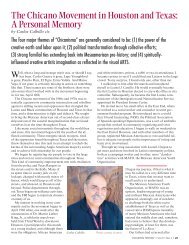You also want an ePaper? Increase the reach of your titles
YUMPU automatically turns print PDFs into web optimized ePapers that Google loves.
since the St. Louis Cardinals owned part of the Buffs, but evenwith that excitement, a desire for major league action remained.After a concerted effort in the 1950’s to persuade Major LeagueBaseball to come to <strong>Houston</strong>, the owners finally agreed to expandthe league to include the Bayou City on October 17, 1960.Roy Hofheinz was brought into the <strong>Houston</strong> Sports Association(HSA) by friend and business partner R. E. “Bob” Smith,a rancher and oil tycoon, who owned much of the city’s land.Hofheinz, a former Texas state legislator, Harris County judge,and <strong>Houston</strong> mayor, had the civic and political know-how toproduce large projects and led a masterful presentation on asports paradise--completely climate controlled. “We’re not justbig time sports and entertainment, but we’re the BIGGEST timeentertainment,” stated Hofheinz. He knew a Major League teamneeded insurance against <strong>Houston</strong>’s sub-tropical climate, sohe took the knowledge he gained researching development of alarge shopping center and applied it to the sports complex. 5The 1961 baseball season marked <strong>Houston</strong>’s last with aminor league club, making a dream come true for HSA executiveGeorge Kirksey, who along with Craig Cullinan, firstseriously pursued a Major League franchise for <strong>Houston</strong>. TheHSA purchased the Buffs and soon decided their name wouldnot transcend entry into the National League. They conducteda name-the-team contest and received over 12,000 entries. Twostudents from the University of <strong>Houston</strong> worked an estimated150 hours narrowing the list down to thirty names including thefan’s top choice, the “Rebels.” The winning submission camefrom <strong>Houston</strong> salesman William T. Neder who wrote, “TheColt .45 won the west and will win the National League.” Immediatelythe HSA had to explain that the name was for the gunand not a horse. The <strong>Houston</strong> Buffs played their last game onAugust 28, 1961. 6While in no way would Colt Stadium be mistaken for aclassic ballpark like Fenway Park, Wrigley Field or YankeeStadium, it nonetheless ushered Major League Baseball into<strong>Houston</strong> and the southern United States. Major League Baseball’sfirst temporary venue, Colt Stadium had to be built afterorganizers determined that the new domed stadium would notbe ready for the 1962 season. Hofheinz claimed the temporarystadium would seat more fans than stadiums in at least six majorleague cities, and construction began on August 9, 1961, in thenorthwest corner of the Astrodome site. Thousands of excitedfans came to watch the workers until the HSA made a publicplea for them to stay away so work could be complete by OpeningDay 1962. The Colt .45’s played their first regular seasongame at Colt Stadium defeating the Chicago Cubs 11-2 in frontof 25,271 fans on April 10, 1962, Hofheinz’s fiftieth birthday.Harris County Judge Bill Elliot tossed the ceremonial first pitchto Mayor Lewis Cutrer with Congressman Bob Casey at bat.Roman Mejias hit the first <strong>Houston</strong> home run, Bob Aspromontescored the team’s first run, and Bobby Shantz got the win.Across from Colt Stadium, excavation for the domed stadiumbegan with a 710-foot wide and twenty-five-foot deep hole. Theland had many underground streams, and water began to fillthe giant opening, turning the future sports palace into one ofthe world’s largest homes for Texas mosquitoes. Many of thoseflying Bayou City pests found their way across the propertyjust in time for the first pitch at Colt Stadium. Okay, maybe itjust seemed that way, but the mosquito infestation promptedteam executives to have Colt Stadium sprayed regularly beforegames. Los Angeles pitcher Sandy Koufax once quipped themosquitoes were so big they were “twin engine jobs.” 8All the seats at Colt Stadium were in the blaze of the Texassun, and a strong wind blew in from right field. Unlike itsminor league predecessor, Colt Stadium lacked a canopy overthe stands. During the first doubleheader on June 10, 1962, thestadium medical staff treated more than eighty overheated fans.Shortly after, the Colt .45’s announced they would move all 1:30p.m. Sunday start times to 4:30 p.m. after the National Leaguegranted them special permission to play the first ever Sundaynight games in 1963.Seating colors at Colt Stadium ranged from flamingo red, toburnt orange, chartreuse, and turquoise. Female ushers, called“Triggerettes,” wore uniforms made of the same flannel materialused for the players, and parking attendants wore orangeStetson hats as they directed cars into sections named “WyattEarp Territory” and “Matt Dillon Territory.” Behind the standsbetween home plate and first base, stood the Fast Draw ClubHSA Chairman Bob Smith, HSA Executive Committee ChairmanRoy Hofheinz, County Commissioner V. V. Ramsey, City CouncilmanJohnny Goyen, County Judge Bill Elliott, HSA Executive VicePresident George Kirksey, and HSA President George Cullinan celebrateMLB coming to <strong>Houston</strong>.22 Vol. 6, No. 3–SportsThe <strong>Houston</strong> Colt .45s played their first game in franchise history onApril 12, 1962, against the Chicago Cubs.



